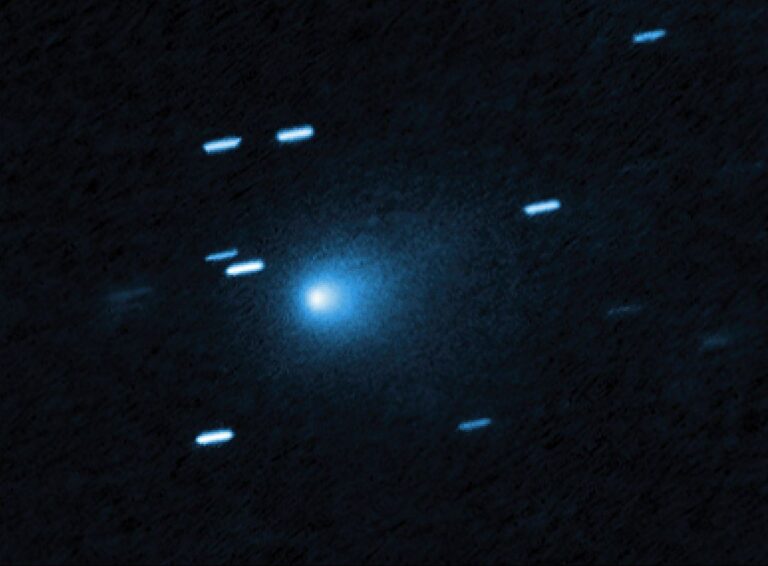Key Takeaways:
Pulsars are small spinning stars the size of cities like Cologne that emit a beam of radio waves. As the star spins and the radio beam sweeps repeatedly over Earth, radio telescopes detect a regular pattern of radio pulses.
For the newly discovered pulsar, PSR J1719-1438, the astronomers noticed that the arrival times of the pulses were systematically modulated and concluded that this is due to the gravitational pull of a small orbiting companion, a planet. These modulations can tell astronomers several more things about the companion. First, it orbits the pulsar in just 2 hours and 10 minutes, and the distance between the two objects is 370,000 miles (600,000 kilometers) — a little less than the radius of our Sun. Second, the companion is so close to the pulsar that if its diameter was any larger than 37,000 miles (60,000 km) — less than half the diameter of Jupiter — it would be ripped apart by the gravity of the pulsar.
“The density of the planet is at least that of platinum and provides a clue to its origin”, said Matthew Bailes from Swinburne University of Technology in Australia.
The team thinks that the planet is the tiny core that remained of a once-massive star after narrowly missing destruction by its matter being siphoned off toward the pulsar. They found the pulsar among almost 200,000 gigabytes of data using special codes on supercomputers at Swinburne University of Technology, at the University of Manchester, United Kingdom, and at the INAF Cagliari Astronomical Observatory, Italy.
The project is part of a systematic search for pulsars in the whole sky involving also the 100-meter Effelsberg radio telescope of the Max Planck Institute for Radio Astronomy (MPIfR) in the Northern Hemisphere. “This is the largest and most sensitive survey of this type ever conducted,” said Michael Kramer from MPIfR. “We expected to find exciting things, and it is great to see it happening. There is more to come!”
How did the pulsar acquire its exotic companion? And how do we know it’s made of diamond? Pulsar J1719-1438 is a fast-spinning pulsar that’s called a millisecond pulsar. Amazingly, it rotates more than 10,000 times per minute, has a mass of about 1.4 times that of our Sun, but is only 12 miles (20 km) in radius. About 70 percent of millisecond pulsars have companions of some kind: Astronomers think it is the companion that, as a star, transforms an old, dead pulsar into a millisecond pulsar by transferring matter and spinning it up to a very high speed. The result is a fast-spinning millisecond pulsar with a shrunken companion-most often a white dwarf.
“We know of a few other systems, called ultra-compact low-mass X-ray binaries, that are likely to be evolving according to the scenario above and may likely represent the progenitors of a pulsar like J1719-1438,” said Andrea Possenti, of INAF.
But pulsar J1719-1438 and its companion are so close together that the companion could only be a stripped-down white dwarf, one that has lost its outer layers and more than 99.9 percent of its original mass. This remnant is likely to be largely carbon and oxygen; stars of lighter elements like hydrogen and helium just won’t fit. The density means that this material is certain to be crystalline: that is, a large part of the star may be similar to a diamond.
“The ultimate fate of the binary is determined by the mass and orbital period of the donor star at the time of mass transfer. The rarity of millisecond pulsars with planet-mass companions means that producing such exotic planets is the exception rather than the rule, and requires special circumstances,” said Benjamin Stappers from the University of Manchester.
“The new discovery came as a surprise for us,” said Michael Kramer. “But there is certainly a lot more we’ll find out about pulsars and fundamental physics in the following years.”
Pulsars are small spinning stars the size of cities like Cologne that emit a beam of radio waves. As the star spins and the radio beam sweeps repeatedly over Earth, radio telescopes detect a regular pattern of radio pulses.
For the newly discovered pulsar, PSR J1719-1438, the astronomers noticed that the arrival times of the pulses were systematically modulated and concluded that this is due to the gravitational pull of a small orbiting companion, a planet. These modulations can tell astronomers several more things about the companion. First, it orbits the pulsar in just 2 hours and 10 minutes, and the distance between the two objects is 370,000 miles (600,000 kilometers) — a little less than the radius of our Sun. Second, the companion is so close to the pulsar that if its diameter was any larger than 37,000 miles (60,000 km) — less than half the diameter of Jupiter — it would be ripped apart by the gravity of the pulsar.
“The density of the planet is at least that of platinum and provides a clue to its origin”, said Matthew Bailes from Swinburne University of Technology in Australia.
The team thinks that the planet is the tiny core that remained of a once-massive star after narrowly missing destruction by its matter being siphoned off toward the pulsar. They found the pulsar among almost 200,000 gigabytes of data using special codes on supercomputers at Swinburne University of Technology, at the University of Manchester, United Kingdom, and at the INAF Cagliari Astronomical Observatory, Italy.
The project is part of a systematic search for pulsars in the whole sky involving also the 100-meter Effelsberg radio telescope of the Max Planck Institute for Radio Astronomy (MPIfR) in the Northern Hemisphere. “This is the largest and most sensitive survey of this type ever conducted,” said Michael Kramer from MPIfR. “We expected to find exciting things, and it is great to see it happening. There is more to come!”
How did the pulsar acquire its exotic companion? And how do we know it’s made of diamond? Pulsar J1719-1438 is a fast-spinning pulsar that’s called a millisecond pulsar. Amazingly, it rotates more than 10,000 times per minute, has a mass of about 1.4 times that of our Sun, but is only 12 miles (20 km) in radius. About 70 percent of millisecond pulsars have companions of some kind: Astronomers think it is the companion that, as a star, transforms an old, dead pulsar into a millisecond pulsar by transferring matter and spinning it up to a very high speed. The result is a fast-spinning millisecond pulsar with a shrunken companion-most often a white dwarf.
“We know of a few other systems, called ultra-compact low-mass X-ray binaries, that are likely to be evolving according to the scenario above and may likely represent the progenitors of a pulsar like J1719-1438,” said Andrea Possenti, of INAF.
But pulsar J1719-1438 and its companion are so close together that the companion could only be a stripped-down white dwarf, one that has lost its outer layers and more than 99.9 percent of its original mass. This remnant is likely to be largely carbon and oxygen; stars of lighter elements like hydrogen and helium just won’t fit. The density means that this material is certain to be crystalline: that is, a large part of the star may be similar to a diamond.
“The ultimate fate of the binary is determined by the mass and orbital period of the donor star at the time of mass transfer. The rarity of millisecond pulsars with planet-mass companions means that producing such exotic planets is the exception rather than the rule, and requires special circumstances,” said Benjamin Stappers from the University of Manchester.
“The new discovery came as a surprise for us,” said Michael Kramer. “But there is certainly a lot more we’ll find out about pulsars and fundamental physics in the following years.”










